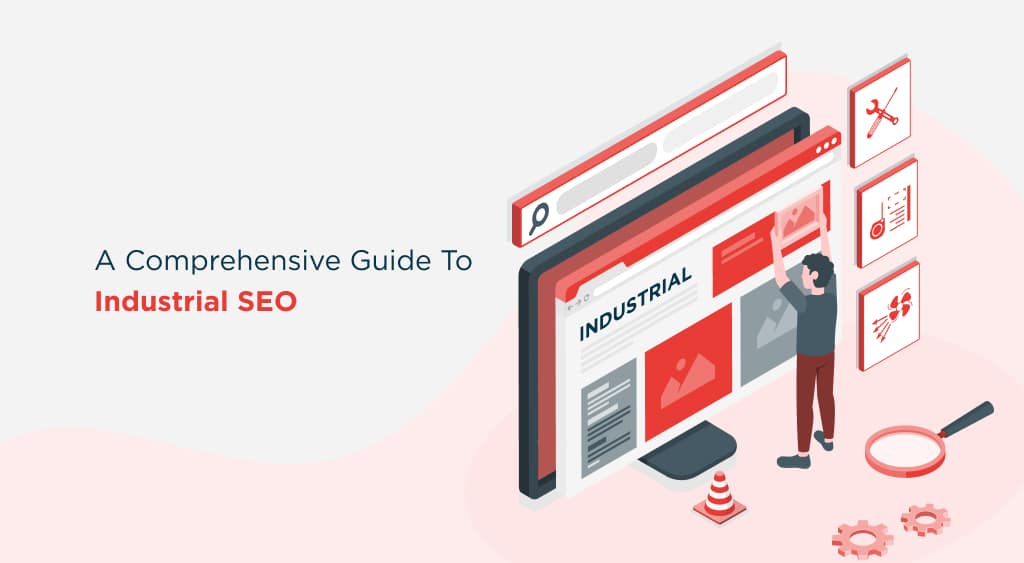A Comprehensive Guide to Industrial SEO
14 Mar 2024 | 11 min read
Imagine You’ve set up a fantastic shop filled with top-notch products. But it’s hidden in a small alley where few people pass by. No matter how good your products are, you will only sell a little if people can find your shop. In the vast internet marketplace, SEO is the big, bright signboard that directs customers to your online store.
For businesses in the industrial sector, diving into the internet without understanding SEO is like setting sail without a compass. You’re out there, but you’re lost in the vastness.

Understanding the Digital Landscape for Manufacturers
Now, let’s demystify this ‘digital landscape’. Manufacturers showcased their products in trade fairs, exhibitions, or physical catalogs a few decades ago. Fast forward to today, and the internet has revolutionized everything. Websites, social media, and online catalogs have become the new normal. It’s where your customers hang out, search, and make decisions.
Every manufacturer can set up their own space on the internet – their website. But the challenge? The internet is crowded, and everyone’s shouting for attention.
Why SEO Matters for Industrial Businesses
This is where professional SEO Services, or Search Engine Optimization, becomes the hero of our story. It’s not some fancy jargon; it’s simple. When people search for products you offer, SEO ensures your business pops up in their search results.
Think of it as magic dust. Sprinkle it over your online content, and voila! Your website climbs up the search ladder. The higher you are, the easier customers can spot you. For industrial businesses, where specifics matter, and the competition is tight, this magic dust can be the difference between being seen and getting lost in the crowd.
If you’re in the industrial sector, embracing SEO isn’t just an option—it’s necessary. It’s your digital voice, ensuring you’re heard loud and clear amidst the online chatter.
Key Components of Industrial SEO
Navigating the world of SEO can feel like assembling a puzzle. But don’t worry. We’re here to help you assemble those pieces. Let’s dive into the essential components that make industrial SEO effective.
Keyword Research and Optimization
Imagine you’re setting up a stall at a market. You’d want to know what the crowd is looking for. That’s precisely what keyword research does in the digital realm. It’s about discovering what words or phrases your potential customers type into search engines.
Once you’ve got a list of these ‘buzzwords’, sprinkle them through your content. But here’s the key: it has to feel natural. It’s like seasoning a dish. Too little, and it’s bland. Too much, and it’s overpowering. By naturally integrating these keywords into your content, you’re signaling to search engines like Google that your page has the information folks are searching for.
On-Page Optimization
Think of on-page optimization as setting the stage right for your audience. It’s all about ensuring every page on your website is at its best. Here’s a simple breakdown:
- URL Structure: Your web page’s address should be simple and descriptive. For example, go for “website.com/p12345” instead of “website.com/industrial-machines.”
- Title Tags: It’s the first thing people see on search results. Make it catchy and relevant.
- Content Quality: Ensure your content is engaging, informative, and answers your audience’s questions.
- Images: A picture speaks a thousand words, but make sure they’re optimized so they don’t slow down your website.
Technical SEO for Manufacturing Websites
While on-page is about the visible parts of your website, technical SEO is the backstage crew ensuring everything runs smoothly. Here’s a peek behind the curtains:
- Site Speed: Just like you wouldn’t like waiting long in a queue, online visitors don’t like slow websites. Ensure yours loads quickly.
- Mobile Optimization: More people are browsing on their phones. Make sure your website looks and works well on mobile devices.
- Crawlability: Search engines send out tiny robots to scan your website and understand its content. Ensure these robots can easily ‘crawl’ through your website.
- Sitemaps: It’s a map guiding search engines through your website’s content, ensuring everything gets noticed.
Wrapping it up, SEO isn’t just about getting your website noticed. It’s about ensuring when visitors land on your page, they find value, stay a while, and become customers. As you delve into industrial SEO, remember it’s a mix of art and science – understanding your audience’s needs and tweaking your website to meet them.
Creating SEO-Friendly Manufacturing Websites
Embarking on the digital journey? Fantastic! For manufacturing businesses, having a website is like opening a digital showroom. But here’s the twist: you want to be visible and welcoming in this vast digital mall. So, how do you create a site that’s SEO-friendly and user-friendly? Let’s get into it.
User Experience and Website Design
Remember the last time you entered a neatly organized shop? It felt good, right? A website is no different. User experience (often called UX) is all about ensuring visitors find what they’re looking for without hassle. Here’s how:
- Clear Navigation: Think of it as clear aisle signs in a supermarket. Ensure your website menus guide the visitor smoothly from one section to another.
- Engaging Design: Your website should be visually appealing, using colors and designs that resonate with your brand.
- Call-to-Actions (CTAs): CTAare the ‘Buy Now’ or ‘Contact Us’ buttons. Place them strategically so visitors know their next step.
Mobile Optimization for Industrial Websites
Ever tried reading tiny text on a mobile screen or waiting forever for images to load? Frustrating, right? As more people use mobile devices to access the internet, ensuring your website is mobile-friendly isn’t just a good-to-have—it’s a must.
- Responsive Design: This ensures your website adjusts itself based on the device, whether a desktop, tablet, or mobile.
- Quick Load Times: Mobile users are often on the go. If your website takes ages to load, they’ll likely move on.
- Touch-Friendly: Make sure buttons are big enough and spaced well so they’re easy to tap on touchscreens.
Content Creation and Optimization
Imagine visiting a store showcasing products with detailed descriptions, benefits, and reviews. You’d feel informed and confident to purchase, right? Similarly, your website should offer valuable content.
- Relevant Topics: Address the needs and questions of your target audience. If you’re selling industrial machinery, write about its benefits maintenance tips, or compare different models.
- Use Keywords Naturally: Which buzzwords you found during keyword research? Incorporate them into your content, but ensure it read naturally.
- Images and Videos: A wall of text can be off-putting. Break it up with relevant images or videos that enhance the information.
Creating an SEO-friendly manufacturing website combines tech-savviness and understanding human behavior. The goal? A digital space where visitors feel valued, understood, and inclined to engage with your business. And with these tips, you’re well on your way to achieving that!
Local SEO for Industrial Businesses
So, you’ve set up shop, both physically and digitally. Great! But did you know there’s a unique twist to SEO that can particularly benefit businesses with a local or regional focus? It’s called Local SEO, and for manufacturers, it’s like planting a big, bright flag on the digital map, saying, “Hey, we’re here!” Let’s dive deeper.
Importance of Local SEO for Manufacturers
Imagine you’re craving a specific dish. You’re likely to search for a restaurant nearby that offers it rather than one across the country. Similarly, businesses, especially in the manufacturing sector, can benefit immensely from focusing on local audiences. Here’s why:
- Visibility in Local Searches: People often add ‘near me’ or specific locations to their searches. Local SEO ensures your business pops up in such local queries.
- Build Local Relationships: Trust plays a big part in business. Being visible and accessible to local clients can foster trust and longer-lasting relationships.
- Stay Ahead of Local Competitors: Not every business leverages the power of Local SEO. Doing so gives you an edge over local competitors who need to be more digitally savvy.
Unlocking Success with Local SEO Strategies
How do you ensure your local audience hears you in a digital world brimming with voices? Local SEO is like using a megaphone in your neighborhood for industrial businesses. It’s all about reaching out to the people closest to you and saying, “We’re here for you!” Let’s explore some nifty strategies to make your local mark.
- Mastering Google My Business: Think of Google My Business as your digital storefront. Here’s what you should do:
- Claim and Shine: Ensure you’ve claimed your profile. Fill it out with up-to-date details: where you’re located, how to reach you, and when you’re open.
- Gather Feedback: Encourage your satisfied clients to drop a review. Think of it as word-of-mouth in the digital age. And remember, every positive word counts!
- Diving into Local Keyword Research: Understanding what your local customers are searching for is crucial. Tailor your website’s content to echo their queries. This means sprinkling phrases like ‘best industrial tools in [your city]’ throughout your content.
- Being Consistent with Local Citations and Directories: List your business in local directories. But here’s the golden rule: stay consistent. If your business is on 5th Street in one listing, avoid calling it Fifth St. in another. Consistency is key.
- Crafting Localized Content: Every region has its unique needs. Address these in your content. Discuss local industry trends or challenges faced by businesses in your area. This builds rapport and trust.
- Building a Strong Reputation with Reviews: Happy customers are your best promoters. Urge them to share their positive experiences on platforms like Google or Yelp. And if there’s constructive feedback? Respond gracefully. It shows you care.
- Cultivating Local Relationships: Forge alliances with local businesses or participate in community events. When they link back to your website, it’s a digital thumbs-up that search engines love.
Finally, remember that success doesn’t happen overnight. Regularly check how you’re doing. Tools like Google Analytics can be your guiding star, helping you understand where you’re shining and where you might need a little more polish.
In essence, with Local SEO, you’re not just a face in the crowd. You’re a trusted neighbor, a go-to solution, a local gem. So, let your local community know you’re ready to serve, assist, and grow together.
Measuring the SEO Efforts
Have you ever heard the saying, “What gets measured gets managed?” In the digital world, it’s the golden mantra. You’ve set up your SEO strategies, but how do you know they work? It’s time to put on our detective hats and dive into the world of SEO analytics!
Spotting Key Metrics for Industrial SEO
Just as a doctor checks vital signs to assess your health, these are the vital signs for your website:
- Organic Traffic: The number of visitors landing on your site without paid promotions. It’s a sign that your SEO game is strong.
- Keyword Rankings: It’s where your website stands when certain keywords are searched. Climbing this ladder means your content and SEO strategies are resonating.
- Conversion Rate: Think of it as your website’s charm factor. How many visitors take a desired action, like signing up for a newsletter or purchasing?
- Bounce Rate: If people land on your site and immediately leave, it’s a sign something’s amiss. It could be slow-loading pages or content that doesn’t match their expectations.
Gearing Up with Tools for SEO Insights
Like a detective needs tools to solve a case, you need tools to decode your website’s performance. Here are some trusty ones:
- Google Analytics: It’s like a window into your website’s soul. How are visitors behaving? Which pages do they love? Where do they come from? Google Analytics tells all.
- Google Search Console: Consider it your website’s report card in Google’s school. It shows how well you’re doing in search results and gives tips for improvement.
- SEMrush: A Swiss knife for SEO pros! From tracking keyword performance to spying on competitors, SEMrush has a lot up its sleeve.
Remember, the digital world is always evolving. So, keep your eyes on these metrics, adjust strategies when needed, and keep learning. Tracking and measuring aren’t just about numbers. It’s about understanding, growing, and ensuring that your digital voice reaches those who need to hear it. So, keep tracking, keep refining, and watch your digital journey soar!
Staying Ahead in the Digital Manufacturing Age
Navigating today’s digital realm is like mastering the art of sailing in turbulent waters. The manufacturing sector is no exception with industries across the board getting a digital facelift. Adapting and thriving in this new digital environment isn’t a luxury; it’s the new norm. So, how does one confidently steer the ship in such a scenario? Let’s dive deeper.
Adapting to Changing SEO Trends
Imagine the digital realm as a vast desert. The dunes, just like SEO trends, are forever shifting, reshaping, and reforming. To navigate efficiently, it’s essential to stay updated with these shifts. Here are some paths to consider:
- Prioritizing User Experience (UX): Remember, it’s not just about stuffing keywords anymore. Picture your website as a guesthouse. It should be welcoming, easy to navigate, and cater to the visitor’s needs. Whether it’s a quick-loading site, a mobile-friendly interface, or clear navigation paths, these small touches create a memorable user journey.
- Answering the Call of Voice Search: Devices like Siri, Alexa, and Google Assistant are not just tech novelties but part of our daily routines. This change in user behavior nudges us to adapt our content. Instead of rigid, keyword-heavy sentences, consider how people naturally ask questions and incorporate that conversational tone and phrasing into your content.
- Making the Most of Rich Snippets: Think of rich snippets as movie trailers. They give searchers a quick glimpse into what your page offers. By structuring your content effectively, these snippets can help position you as a front-runner in search results, piquing users’ curiosity and enticing them to click.
In this ever-transforming digital era, especially for the manufacturing sector, it’s not about who has been in the race the longest but who adapts, learns, and grows the fastest. Keep your ears and eyes on the horizon, and stay ready to pivot. The digital age is challenging but offers endless possibilities for those willing to adapt and innovate.
Leveraging SEO for Competitive Advantage
How do you ensure your ship sails the fastest in a sea of competitors? Simple, by leveraging the power of SEO.
- Build Trust with Quality Backlinks: Think of backlinks as endorsements from other websites. The more quality endorsements you have, the more search engines trust you. Reach out, collaborate, and watch your SEO credibility soar.
- Content is King, But Relevance is Queen: Regularly update your content to keep it fresh and relevant. It appeals to search engines and ensures your audience always finds value in your words.
- Mobile Optimization is Non-negotiable: With more users surfing on their phones, ensuring your website is mobile-friendly isn’t a luxury; it’s a must. It enhances user experience and gives you brownie points with search engines.
To wrap it up, in this dynamic digital manufacturing age, resting on laurels isn’t an option. Continuous learning, adapting, and leveraging the power of SEO are the keys to stay ahead. Remember, it’s not about the biggest ship in the sea, but the most elegant one that catches the wind! So, keep your sails ready and chart your course with confidence.


